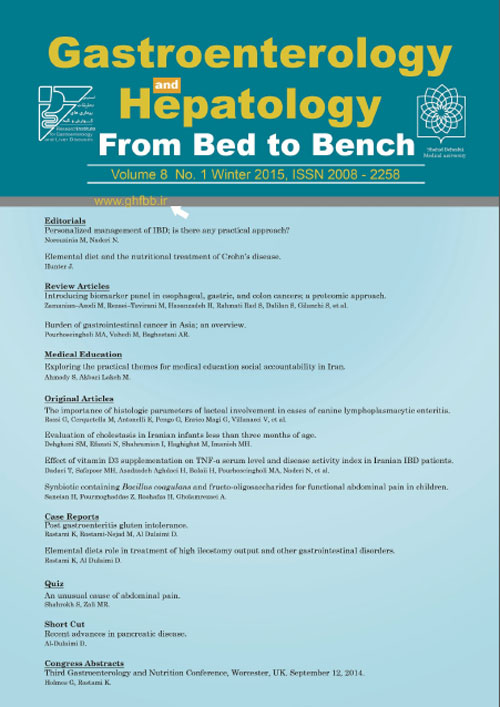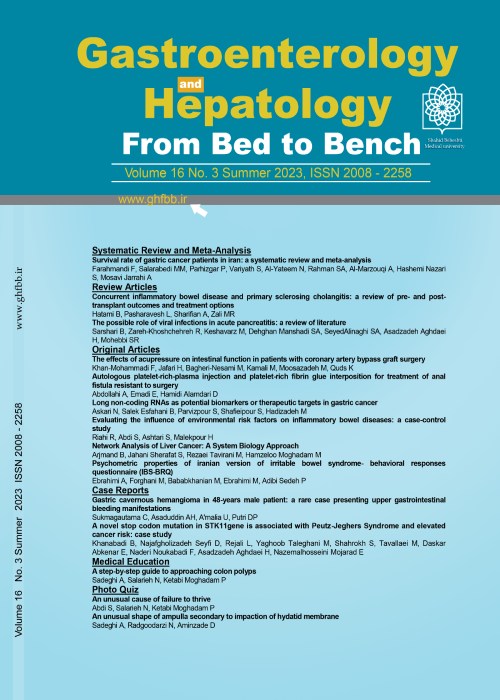فهرست مطالب

Gastroenterology and Hepatology From Bed to Bench Journal
Volume:8 Issue: 1, Winter 2015
- تاریخ انتشار: 1393/09/18
- تعداد عناوین: 14
-
-
Page 6Cancer has been always in a great attention in the field of molecular biology. By applying large-scale tools such as advanced proteomics, cancer diagnosis and treatment have been improved greatly since. Cancers of esophagus, gastric, and colon accounted for major health problem globally. Biomarker panel could bring out the accuracy for cancer evaluation tests as it can suggest a group of candidate molecules specified to particular malignancy in a way that distinguishing malignant tumors from benign, differentiating from other diseases, and identifying each stages with high specificity and sensitivity. In this review, a systematic search of unique protein markers reported by several proteomic literatures are classified in their specific cancer type group as novel panels for feasible accurate malignancy diagnosis and treatment. About thousands of proteins were studied; however, a little number of them was belonged to a specific kind of malignancy. In conclusion, despite the fact that combinatorial biomarkers appear to be hopeful, more evaluation of them is crucial to achieve the most relevant risk markers panel to the disease to provide precise clinical testKeywords: Biomarker panel, Esophagus Cancer, Gastric Cancer, Colon Cancer, Proteomics
-
Page 19The cancers in the digestive system including gastric cancer, colorectal cancer, liver cancer, esophageal cancer and pancreatic cancer are one of the most common cancers in Asia. The burden of these gastrointestinal cancers are increasing in Asian countries and there are many people in the developing countries inside the Asia who have no health insurance and many of them are too poor to go for screening tests, early detection or medical treatments. So it is important for the health organizations and governments in each country to recognize these groups and reduce the incidence and mortality of gastrointestinal cancers, using simple and economic screening test, vaccination and changing risk factors such as smoking, diet and lifestyle by education programs.
-
Page 33The most frequent form of inflammatory bowel disease (IBD) in dogs is represented, histologically, by lymphoplasmacytic enteritis (LPE), a histological category, often associated with other morphologic alterations including lymphangiectasia (LE). However, literature data on this latter topic are quite scarce and have mostly been obtained in single reports or in small series. Currently, there are no objective pathologic parameters that indicate a cut-off value above which the lacteals’ diameter can be considered indicative of clinically significant LE. Thus, we evaluated some morphologic parameters of intestinal villi and lacteals in a large cohort of dogs, and correlated them with serum albumin and cholesterol values. We investigated 136 dogs (94 with LPE, and 42 with gastrointestinal problems different from IBD) and analyzed their clinical, laboratory (albumin and cholesterol values), endoscopic, and histologic variables. The LPE group showed significantly impaired clinical, laboratory, endoscopic, and histologic variables compared to control dogs. Affected dogs showed significant correlations between canine inflammatory bowel disease activity index (CIBDAI) scores and endoscopic and histologic variables. Moreover, the grade of hematologic changes were strongly related to the intestinal histologic variables, in particular those concerning villous and lacteals morphology. Dogs with LPE had intestinal histologic abnormalities (height, width, height/width ratio, calculated for both villi and lacteals), whose degree correlated with the severity of hypoalbuminemia and hypocholesterolemia. Evaluation of endoscopic and histologic variables in association to the clinical findings may reveal useful insights for the pathogenesis of LPE and, hopefully, might lead to more targeted therapeutic approaches.
-
Page 49Background And AimVitamin D has immune-regulatory functions in experimental inflammatory bowel disease (IBD) and vitamin D deficiency is common in IBD patients. The aim of the study was to assess the effectiveness of vitamin D3 [1,25(OH)2D3] treatment in IBD with regard to tumor necrosis factor-alpha (TNF-?) serum level and clinical disease activity index (CDAI).Materials And MethodsThis was a double blind randomized clinical trial on 108 IBD patients with serum 25-OHD level less than 30ng/ml, whom divided into vitamin D and control groups. Vitamin D group received 50000 IU vitamin D3 for 12 weeks. Before and after the study, TNF-? and 25-OHD serum levels were measured by ELISA method. Data were analyzed using paired t test, chi-square test and Spearman correlation coefficient. P values? ?less than 0.05 were considered statistically significant.ResultsBefore the intervention no significant difference was found between baseline characteristics and TNF-? serum level of two groups. After intervention TNF-? serum level reduced but this reduction was not statistically significant (P= 0.07, 95% CI: -0.45 to 8.14). The mean serum 25-OHD level of vitamin D increased from 15.54 to 67.89, which was statistically significant (P= 0.00, 95% CI: -61.40 to -43.30). TNF-? level was also associated significantly with CDAI before (Spearman’s rho: 0.3, P<0.0001) and after (Spearman’s rho: 0.27, P=0.01) intervention.ConclusionOral supplementation vitamin D3 significantly increased serum vitamin D levels and insignificantly reduced serum TNF-? level. More studies with larger samples would be beneficial to assess vitamin D3 supplementation efficient effect in IBD.
-
Page 56AimWe evaluated the effectiveness of a synbiotic in the treatment of childhood functional abdominal pain (FAP).BackgroundProbiotics are effective in the treatment of functional gastrointestinal disorders in adult patients, but there is lack of information in children.Patients andMethodsChildren with FAP, based on the Rome III criteria (n = 115, aged 6-18 years), were randomized to receive either synbiotic (Bacillus coagulans, 150 million spore plus FOS, 100 mg) twice daily or placebo for four weeks. Treatment response was defined as? 2 point reduction in the 6-point self-rated pain scale or “no pain”. Physician-rated global severity and improvement were also evaluated. Patients were followed for a total of 12 weeks.ResultsEighty eight patients completed the trial (45 with synbiotic). Response rate was higher with synbiotic than placebo after medication (60% vs. 39.5%, P = 0.044), but was not different between the two groups at week 12 (64.4% vs. 53.4%, P = 0.204). Difference between the two groups regarding the physician-rated global severity over the study period was not statistically significant (z = -1.87, P = 0.062). There was no significant difference between the two groups in physician-rated global improvement (week 4, P = 0.437; week 12, P = 0.111). Receiving synbiotic (OR 2.608, 95% CI: 1.01, 6.68) and baseline pain score (OR 2.21, 95% CI: 1.19, 4.10) were predictors of treatment response after medication.ConclusionsThe synbiotic containing Bacillus coagulans and FOS is effective in the treatment of childhood FAP. Further trials are recommended in this regard.
-
Page 66The spectrum of gluten related disorder might be much broader than currently believed. It is unknown why Non-coeliac gluten sensitivity affects individuals at different ages. It is quite possible the triggering factors like infection might play an essential role in manifestation of this disorder. Similar to secondary lactose intolerance, gluten intolerance might be a common occurrence behind persistent symptoms after gastroenteritis. The presenting symptoms depending on the etiological factor and the affected portion of gastrointestinal (GI) anatomy. Therefore the symptoms might be related to upper GI tract like functional dyspepsia, diarrhoea lower GI tract like diarrhoea and constipation or a combination of both like in our patients. This case highlight that intolerance to gluten might develop in people who experience gastroenteritis and there is potential of at least partial recovery from this condition with elimination of lactose and gluten. Clinical recovery with a concomitant gluten and lactose (mainly milk) free diet over a period of time, might be an effective strategy in treating these patients.
-
Page 71Elemental diets have been used widely in the treatment of gastrointestinal disorders, especially with the management of Crohn''s disease. This modality of diets provide all essential nutrients, and contain protein in the form of free amino acids that are theoretically easily absorbed. A high output ileostomy is a rare complication of surgery that is difficult to treat. Treatments include anti-diarrhoeals, octreotide and proton pump inhibitors. There is very little research regarding the use of elemental diets in the treatment of patients with post-operative with high ileostomy outputs. High output ileostomies are a rare but important complications of stoma formation following bowel surgery. Adequate management of high output ileostomies might prevent significant morbidity. In this case report, we describe a patient who was treated with subtotal colectomy for ulcerative colitis and had refractory high ileostomy output despite standard medical therapy. The ileostomy output was dramatically reduced following the introduction of an elemental diet. This case suggests a possible role for the introduction of an elemental diet in the management of high output ileostomies.


